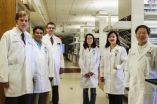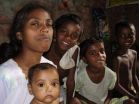(Press-News.org) An interdisciplinary team of researchers at Vanderbilt University have developed a way to combine the photosynthetic protein that converts light into electrochemical energy in spinach with silicon, the material used in solar cells, in a fashion that produces substantially more electrical current than has been reported by previous "biohybrid" solar cells.
The research was reported online on Sep. 4 in the journal Advanced Materials and Vanderbilt has applied for a patent on the combination.
"This combination produces current levels almost 1,000 times higher than we were able to achieve by depositing the protein on various types of metals. It also produces a modest increase in voltage," said David Cliffel, associate professor of chemistry, who collaborated on the project with Kane Jennings, professor of chemical and biomolecular engineering. "If we can continue on our current trajectory of increasing voltage and current levels, we could reach the range of mature solar conversion technologies in three years."
The researchers' next step is to build a functioning PS1-silicon solar cell using this new design. Jennings has an Environmental Protection Agency award that will allow a group of undergraduate engineering students to build the prototype. The students won the award at the National Sustainable Design Expo in April based on a solar panel that they had created using a two-year old design. With the new design, Jennings estimates that a two-foot panel could put out at least 100 milliamps at one volt – enough to power a number of different types of small electrical devices.
More than 40 years ago, scientists discovered that one of the proteins involved in photosynthesis, called Photosystem 1 (PS1), continued to function when it was extracted from plants like spinach. Then they determined PS1 converts sunlight into electrical energy with nearly 100 percent efficiency, compared to conversion efficiencies of less than 40 percent achieved by manmade devices. This prompted various research groups around the world to begin trying to use PS1 to create more efficient solar cells.
Another potential advantage of these biohybrid cells is that they can be made from cheap and readily available materials, unlike many microelectronic devices that require rare and expensive materials like platinum or indium. Most plants use the same photosynthetic proteins as spinach. In fact, in another research project Jennings is working on a method for extracting PS1 from kudzu.
Since the initial discovery, progress has been slow but steady. Researchers have developed ways to extract PS1 efficiently from leaves. They have demonstrated that it can be made into cells that produce electrical current when exposed to sunlight. However, the amount of power that these biohybrid cells can produce per square inch has been substantially below that of commercial photovoltaic cells.
Another problem has been longevity. The performance of some early test cells deteriorated after only a few weeks. In 2010, however, the Vanderbilt team kept a PS1 cell working for nine months with no deterioration in performance.
"Nature knows how to do this extremely well. In evergreen trees, for example, PS1 lasts for years," said Cliffel. "We just have to figure out how to do it ourselves."
The Vanderbilt researchers report that their PS1/silicon combination produces nearly a milliamp (850 microamps) of current per square centimeter at 0.3 volts. That is nearly two and a half times more current than the best level reported previously from a biohybrid cell.
The reason this combo works so well is because the electrical properties of the silicon substrate have been tailored to fit those of the PS1 molecule. This is done by implanting electrically charge atoms in the silicon to alter its electrical properties: a process called "doping." In this case, the protein worked extremely well with silicon doped with positive charges and worked poorly with negatively doped silicon.
To make the device, the researchers extracted PS1 from spinach into an aqueous solution and poured the mixture on the surface of a p-doped silicon wafer. Then they put the wafer in a vacuum chamber in order to evaporate the water away leaving a film of protein. They found that the optimum thickness was about one micron, about 100 PS1 molecules thick.
When a PS1 protein exposed to light, it absorbs the energy in the photons and uses it to free electrons and transport them to one side of the protein. That creates regions of positive charge, called holes, which move to the opposite side of the protein.
In a leaf, all the PS1 proteins are aligned. But in the protein layer on the device, individual proteins are oriented randomly. Previous modeling work indicated that this was a major problem. When the proteins are deposited on a metallic substrate, those that are oriented in one direction provide electrons that the metal collects while those that are oriented in the opposite direction pull electrons out of the metal in order to fill the holes that they produce. As a result, they produce both positive and negative currents that cancel each other out to leave a very small net current flow. The p-doped silicon eliminates this problem because it allows electrons to flow into PS1 but will not accept them from protein. In this manner, electrons flow through the circuit in a common direction.
"This isn't as good as protein alignment, but it is much better than what we had before," said Jennings.
INFORMATION:
Graduate students Gabriel LeBlanc, Gongping Chen and Evan Gizzie contributed to the study.
The research was supported by National Science Foundation grant EMR 0907619, NSF EPSCoR grant EPS 1004083 and by the Scialog Program of the Research Corporation for Scientific Advancement
Spinach power gets a big boost
2012-09-04
ELSE PRESS RELEASES FROM THIS DATE:
New study shows promise in using RNA nanotechnology to treat cancers and viral infections
2012-09-04
LEXINGTON, Ky. (Sept. 4, 2012) — A new study by University of Kentucky researchers shows promise for developing ultrastable RNA nanoparticles that may help treat cancer and viral infections by regulating cell function and binding to cancers without harming surrounding tissue.
The study, published in Nano Today, was carried out in the laboratory of Peixuan Guo, the William S. Farish Endowed Chair in Nanobiotechnology at the UK Markey Cancer Center, in collaboration with Dr. Mark Evers, director of the UK Markey Cancer Center.
The study uses RNA (ribonucleic acid) as ...
Sleep apnoea linked with increased risk of cancer death
2012-09-04
Vienna, Austria: Sleep apnoea severity has been associated with increased cancer mortality in a new study.
The research, which will be presented today (Tuesday 4 September 2012) at the European Respiratory Society's (ERS) Annual Congress in Vienna, adds to evidence presented earlier this year highlighting a link between severe sleep apnoea and cancer.
Two further studies presented at the ERS Congress, also show evidence suggesting an increase in cancer incidence among sleep apnoea patients and an association between the spread of cancer and sleep apnoea.
In the first ...
Smoking and natural disasters: Christchurch residents increase tobacco consumption post-earthquake
2012-09-04
Vienna, Austria: The prevalence of smoking in Christchurch, New Zealand, increased following the 2010 earthquake, according to a new study.
The results of the study will be presented today (4 September 2012) at the European Respiratory Society's Annual Congress in Vienna.
The 7.1-magnitude Christchurch earthquake, and subsequent aftershocks, have caused a huge amount of damage and dramatically changed the social, working and living conditions for residents in the city.
To investigate the effects of the disaster on smoking levels, researchers from the Canterbury ...
Increase in respiratory symptoms following volcanic eruption
2012-09-04
Vienna, Austria: Exposure to volcanic ash can increase respiratory symptoms such as an extreme cough, or phlegm, according to a new study.
The research, which will be presented today (4 September 2012) at the European Respiratory Society's Annual Congress in Vienna, investigated the effects of living close to the Icelandic Volcano, Eyjafjallajökull.
Eyjafjallajökull erupted in April 2010 and created a huge ash cloud which spread across Europe, causing widespread disruption to air travel on the continent.
Researchers from the University of Iceland have now examined ...
Deadly witch hunts targeted by grassroots women's groups
2012-09-04
EAST LANSING, Mich. — Witch hunts are common and sometimes deadly in the tea plantations of Jalpaiguri, India. But a surprising source – small groups of women who meet through a government loan program – has achieved some success in preventing the longstanding practice, a Michigan State University sociologist found.
Soma Chaudhuri spent seven months studying witch hunts in her native India and discovered that the economic self-help groups have made it part of their agenda to defend their fellow plantation workers against the hunts.
"It's a grassroots movement and it's ...
New genetic clues to why most bone marrow transplant patients develop graft-versus-host disease
2012-09-04
SEATTLE – A team of scientists led by a bone marrow transplant researcher at Fred Hutchinson Cancer Research Center has shed new light on why most bone marrow transplant patients who receive tissue-matched cells from unrelated donors still suffer acute graft-versus-host disease (GVHD). The answer appears to lie in the discovery of previously undetected genetic differences in the DNA of patients and unrelated marrow donors.
The laboratory-based study findings by Effie Petersdorf, M.D., and colleagues soon will be translated to the clinic when a Hutchinson Center transplant ...
Magazine articles jeopardize and empower young women’s sexuality
2012-09-04
Los Angeles, CA (September 4, 2012) While the effects of sexualized media on young women has long been debated, a new study finds that women who read sex-related magazine articles from popular women's magazines like Cosmopolitan are less likely to view premarital sex as a risky behavior. Additionally, the women who are exposed to these articles are more supportive of sexual behavior that both empowers women and prioritizes their own sexual pleasure. This study was published in a recent article from Psychology of Women Quarterly (published by SAGE).
Study authors Janna ...
Using magnetism to understand superconductivity
2012-09-04
Might it one day be possible to transmit electricity from an offshore wind turbine to land-based users without any loss of current? Materials known as "high temperature" superconductors (even though they must be maintained at -140°C!), which can conduct electricity without any losses, were supposed to make this dream a reality. But over the past twenty-five years, scientists have not been able to make any progress in this area. Research being done in EPFL's Laboratory for Quantum Magnetism (LQM) could change that. Their study of magnetism at extremely small scales could ...
Hormone therapy for fruit flies means better pest control
2012-09-04
Released en masse, sterile Mexican fruit flies can undermine a wild population of the fruit-damaging pests so that fewer applications of insecticide are needed. But the irradiation used to sterilize the flies weakens them, hindering their ability to outcompete wild-type males for female mates.
Now, U.S. Department of Agriculture (USDA) and collaborating scientists have devised a hormone therapy for making sterile flies "more macho," improving their chances of mating with female flies before their wild rivals do. Peter Teal, a chemist with USDA's Agricultural Research ...
New gene variants raise risk of neuroblastoma, influence tumor progression
2012-09-04
Researchers have discovered two gene variants that raise the risk of the pediatric cancer neuroblastoma. Using automated technology to perform genome-wide association studies on DNA from thousands of subjects, the study broadens understanding of how gene changes may make a child susceptible to this early childhood cancer, as well as causing a tumor to progress.
"We discovered common variants in the HACE1 and LIN28B genes that increase the risk of developing neuroblastoma. For LIN28B, these variants also appear to contribute to the tumor's progression once it forms," said ...


